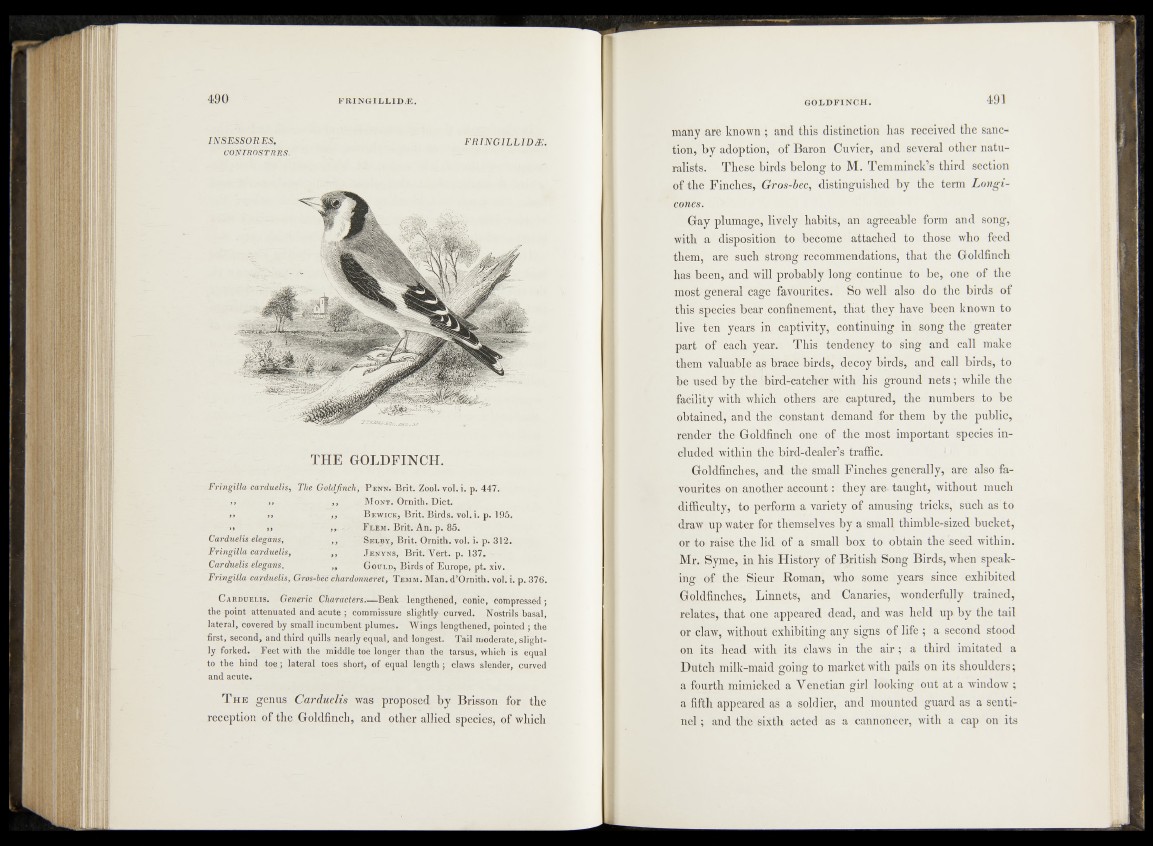
INSESSORES.
CONTROSTRES.
FRINGILLIDÆ.
TH E GOLDFINCH.
Fringilla carduelis, The Goldfinch, P enn. Brit. Zool. vol. i. p. 447.
>> »> ,, Mont. Ornith. Diet.
Carduelis elegans,
Fringilla carduelis,
Carduelis elegans,
B ewick, Brit. Birds, vol.i. p. 195.
F lem. Brit. An. p. 85.
Selby, Brit. Ornith. vol. i. p. 312.
J enyns, Brit. Vert. p. 137.
Gould, Birds of Europe, pt. xiv.
Fringilla carduelis, Gros-bec chardonneret, T emm. Man. d’Ornith. vol. i. p. 376.
Carduelis. Generic Characters— Beak lengthened, conic, compressed;
the point attenuated and acute ; commissure slightly curved. Nostrils basal,
lateral, covered by small incumbent plumes. Wings lengthened, pointed ; the
first, second, and third quills nearly equal, and longest. Tail moderate, slightly
forked. Feet with the middle toe longer than the tarsus, which is equal
to the hind to e ; lateral toes short, of equal length ; claws slender, curved
and acute.
T h e genus Carduelis was proposed by Brisson for the
reception of the Goldfinch, and other allied species, of which
many are known ; and this distinction has received the sanction,
by adoption, of Baron Cuvier, and several other naturalists.
These birds belong to M. Temmulch's third section
of the Finches, Gros-bec, distinguished by the term Longi-
cones.
Gay plumage, lively habits, an agreeable form and song,
with a disposition to become attached to those who feed
them, are such strong recommendations, that the Goldfinch
has been, and will probably long continue to be, one of the
most general cage favourites. So well also do the birds of
this species bear confinement, that they have been known to
live ten years in captivity, continuing in song the ' greater
part of each year. This tendency to sing and call make
them valuable as brace birds, decoy birds, and call birds, to
be used by the bird-catcher with his ground nets; while the
facility with which others are captured, the numbers to be
obtained, and the constant demand for them by the public,
render the Goldfinch one of the most important species included
within the bird-dealer’s traffic.
Goldfinches, and the small Finches generally, are also favourites
on another account: they are taught, without much
difficulty, to perform a variety of amusing tricks, such as to
draw up water for themselves by a small thimble-sized bucket,
or to raise the lid of a small box to obtain the seed within.
Mr. Syme, in his History of British Song Birds, when speaking
of the Sieur Roman, who some years since exhibited
Goldfinches, Linnets, and Canaries, wonderfully trained,
relates, that one appeared dead, and was held up by the tail
or claw, without exhibiting any signs of life ; a second stood
on its head with its claws in the air ; a third imitated a
Dutch milk-maid going to market with pails on its shoulders;
a fourth mimicked a Venetian girl looking out at a window ;
a fifth appeared as a soldier, and mounted guard as a sentinel
; and the sixth acted as a cannoneer, with a cap on its